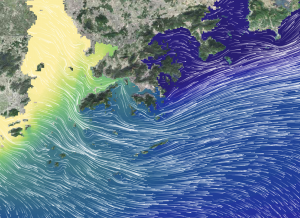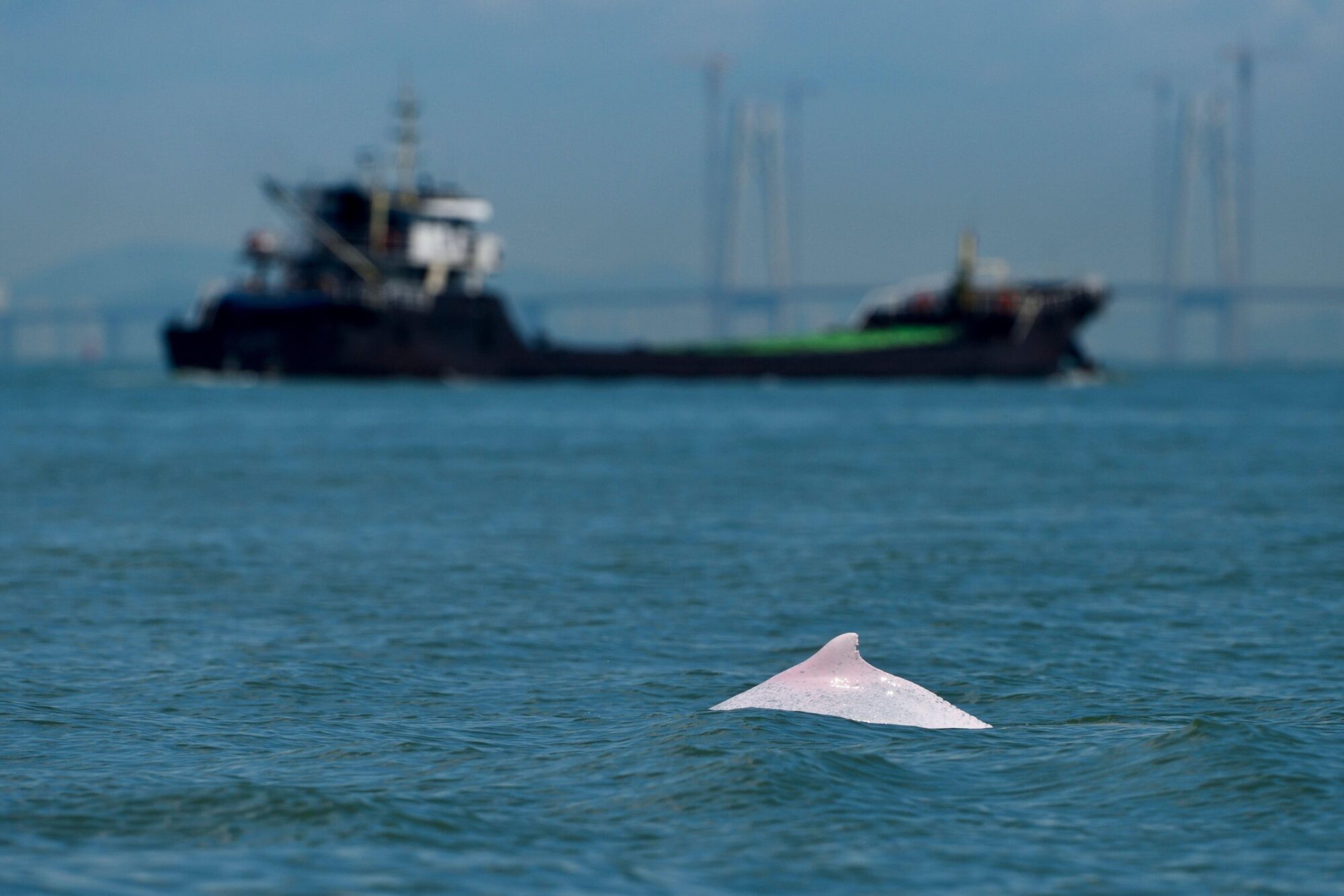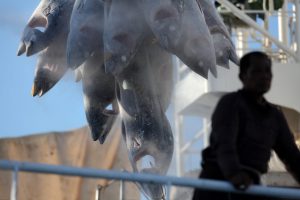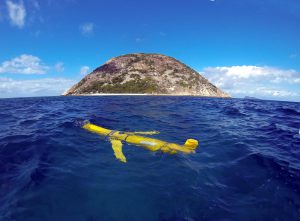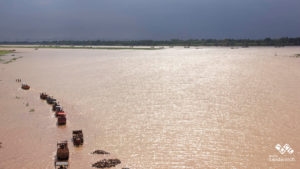On the WavyOcean platform, ocean currents move along the coast of the Guangdong–Hong Kong–Macau Greater Bay Area in a 3D simulation.
Users can view and download data about the waters, such as average temperature, salinity and dissolved oxygen level, in traditional and simplified Chinese, as well as English.
Launched by the Hong Kong University of Science and Technology, and accessible through a web browser or mobile app, WavyOcean is the first science-based platform in China to visualise the marine environment.
Its aim is to increase public awareness of the ocean, facilitate academic research, and enable policymakers to make informed decisions, Gan Jianping, who spent a decade developing the programme with his team, told China Dialogue Ocean.
WavyOcean is a leading example of how technology is being used to improve ocean management in China. At a recent high-level maritime forum focussing on the Greater Bay Area, experts underscored the importance of digitalisation in protecting the country’s coastal environment and pursuing a sustainable ocean economy.
Also known as the blue economy, the ocean economy is described by China as a “pillar” in its plan to become a “great maritime power”. It not only includes industries related to the ocean, such as shipping, fishing and wind energy, but also the natural resources and ecological benefits provided by the ocean – such as marine creatures, shipping channels and carbon absorption.
Knowing the ocean’s ‘status of health’
WavyOcean presents a large amount of information about the sea in the Greater Bay Area, a huge urban cluster in southern China that covers nine cities, including Hong Kong, Macau and Shenzhen, with a total population of 86 million.
The region’s marine environment is one of the worst among China’s coastal zones because of pollutants discharged from the Pearl River, mainly caused by fertiliser runoff, said Gan, who is chair professor of the Department of Ocean Science at the Hong Kong University of Science and Technology, and director of the Centre for Ocean Research in Hong Kong and Macau.
“It would be impractical to stop using fertiliser because we need to ensure food security,” he added. “Therefore, it is important to monitor the ocean’s conditions to raise awareness about protecting its environment. It is crucial to know the status of health in the ocean before we can take appropriate measures to ensure its sustainability.”
WavyOcean draws on projections of historical conditions and long-term average states of the oceanic climate, not just in the Greater Bay Area, but all of the China Seas – South China, East China, Yellow and Bohai – as well as the western Pacific Ocean, Gan explained.
The calculations are based on the China Sea Multi-scale Ocean Modelling System, developed by Gan and his team with the support of the national supercomputing centres of Tianjin and Guangzhou.
Visitors to the platform can see, for example, recent daily and hourly average levels of nitrates on the surface, middle and bottom of the ocean in the Greater Bay Area. Nitrates are essential nutrients for plants, but in high concentrations they can trigger excessive growth and affect biodiversity.

A separate page on the platform displays calculations and archive data of the marine environment in and around China. Atmospheric information – such as wind direction, temperature and pressure – is also available.
Gan said that WavyOcean greatly improves the accessibility and management of marine information in China, as actually collecting real data is difficult.
“One might be able to do the monitoring from selected stations, but it would be impossible to do it in all parts of the ocean 24/7,” he noted.
It is on the radar of policymakers, too. Gan said WavyOcean has caught the attention of Hong Kong officials, who have used it to understand the status and condition of the ocean around the city. They have used it to manage water quality through actions such as controlling hypoxia, or low levels of oxygen in the ocean. It is also helping them evaluate the impact of infrastructure projects, such as Lantau Tomorrow Vision, a HK$624 billion (US$80 billion) sea reclamation plan set to take place near Lantau Island, in the city’s south-west, Gan said. The project has sparked environmental concern and is undergoing an environmental impact assessment by the Sustainable Lantau Office, a local authority.
Data from the platform, launched in January 2022, is downloaded around 100 times a day. It has users around the world, including in China, the US, Canada and Japan, he said.
Building an ‘intelligent ocean’
According to the 2022 National Maritime Innovation Index Report, jointly produced by a group of Chinese oceanographic and marine data organisations, China’s eastern ocean economic circle – comprising Shanghai, Zhejiang and Jiangsu – ranked first nationwide in innovating its maritime industries. This was followed by the southern ocean economic circle, which covers Guangdong, Guangxi, Hainan and Fujian.
The report analysed China’s major coastal economic circles based on a series of metrics, such as how many technological breakthroughs had been turned into on-the-ground projects, what financial resources had been allocated to the research and development of maritime technology, and how much the maritime industry had contributed to the local economy.
The coastal province of Zhejiang, which faces the East China Sea, is seen as a potential leader when it comes to developing a digitalised ocean economy. Late last year, it unveiled its Intelligent Ocean Big Data Centre, dedicated to presenting and managing maritime information gathered from its busy coastline.
Backed by SmartEarth, an AI-enhanced programme developed by a Beijing-based tech firm, the centre presents a wide range of information – such as the ocean’s conditions, maritime traffic and forecasts for natural disasters – on a single platform.
It reflects the province’s plan to fast-track the building of what officials call an “intelligent ocean”, a national maritime strategy aimed at deepening the application of modern technology in ocean-related affairs.
Digital fences, and a dolphin database
On a city level, Zhoushan, which is situated in an archipelago in the easternmost part of Zhejiang, has started to use a first-of-its-kind “digital fencing” system to alert ships and boats that are near three special marine conservation zones.
“Virtual buoys lining the border of the conservation zones will show up on the screens of the automatic identification system of a passing vessel,” Sheng Gang, senior engineer of the Second Institute of Oceanography at the Ministry of Natural Resources, told Zhoushan Daily.
“[The buoys] alert the captain that there is a special protection area ahead, to help them adjust their route to try to avoid entering the area or leave as soon as possible,” Shen noted. “This function did not exist before in the industry.”
Grassroots communities are also taking action. China Blue Sustainability Institute, an environmental group based in Hainan, has set up an online database for dolphins.
Marine biologist Zheng Ruiqiang, director of the institute, had spent 10 years tracking and identifying Indo-Pacific humpback dolphins, also known as Chinese white dolphins, in the Pearl River estuary. This species is listed as vulnerable on the International Union for Conservation of Nature’s Red List, and is the only cetacean – belonging to the whale, dolphin and porpoise family – to be given Class I protected animal status in China, the highest the country provides. He used AI to analyse a large number of photos and videos of individual white dolphins before launching the digital platform iDolphin with his team, in the hopes of raising public awareness around their protection.
On the platform, users can find information about the white dolphins and other types of dolphins spotted in five observation zones in southern China. It provides a range of data about the animals, such as how many have been sighted and identified. It also contains an archive of individual dolphins, sorted by images of their dorsal fins.
Zheng told China Dialogue Ocean that the use of visualisation tools to understand the overall situation of the Chinese white dolphins is the foundation for policymaking and public participation in saving the species.
Policy support for maritime innovation
The role of marine protection has become increasingly important in China’s policymaking in recent years, and innovation – particularly digitalisation – has become an indispensable part of it.
As early as 2013, China’s president, Xi Jinping, stressed the significance of developing maritime technologies. He instructed the nation to break the “bottlenecks” present in the ocean economy and ocean conservation with the help of technological progress and innovation.
China’s 14th Five Year Plan (FYP), the country’s overarching economic and social development blueprint for 2021 and 2025, published in March 2021, contained a chapter about the ocean, which ordered the nation to achieve breakthroughs in a “batch of core technologies” related to maritime engineering and resources, as well as the marine environment.
In January last year, six national-level government agencies issued the 14th FYP for Marine Ecological and Environmental Protection, a top-level document for ocean conservation from 2021 to 2025.
The country had published marine FYPs before – for fishing and the ocean economy – but last year’s directive was the first dedicated to the environment, as China Dialogue Ocean reported. One of its four key missions is to improve the national and regional ability to manage the marine environment using tech innovation.
Various provinces, including Zhejiang, Hebei, Jiangsu, Guangdong, Hainan, Fujian and Shandong, have issued their regional version of the 14th marine FYP, and tech innovation is at the heart of each of them.
Furthermore, in the 14th FYP for Technological Innovation for Ecology and the Environment, jointly published by five national agencies in November last year, a few maritime technologies were named. These included tech related to protecting and utilising marine biodiversity and genetic resources, and building databases for them.
A Chinese industry expert underscored the importance of digitalisation for China to be able to tap into the ocean economy.
The expert, who works for a Chinese state institute and wishes to stay anonymous, told China Dialogue Ocean that efficient management and integration of data will not only form “comprehensive, shareable and continuously growing” resources of marine information, but also provide datasets and products to help solve maritime problems. At the same time, they said, it can “become an effective supportive tool for scientific research and management of the ocean”.
The digitalising of maritime information lies at the intersection of several important fields, such as marine science, space science and information technology – and digital platforms are its core, the expert added.
Liu Dahai, senior engineer of the First Institute of Oceanography at the Ministry of Natural Resources and lead researcher of the 2022 National Maritime Innovation Index Report, believes that China’s maritime technology has a bright future.
“Generally speaking, our country’s maritime technological innovation has achieved obvious progress,” Liu told Qingdao Daily in June. “With the continuous development of the ocean economy, maritime technology innovation carries great promise.”
